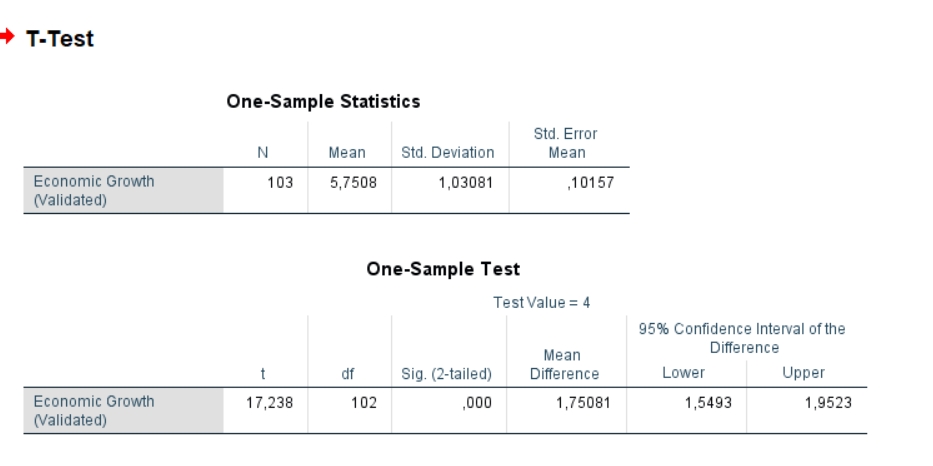Introduction
The purpose of this chapter was to describe the methodology utilised to answer the research questions. The methods are described in the most detailed manner to allow the replication of the research design in the future to confirm the results or expand the generalisability of the conclusions. First, the chapter focuses on the discussion of the research design and research philosophy. Second, the chapter discusses the population under focus and approach to sampling. Third, the chapter introduces the utilised instrument and how it was used to measured, dependent, independent, and demographic variables. Fourth, the data collection procedures are discussed in detail. Finally, the data analysis method is introduced and justified, which allowed to create the data analysis model utilised to test the hypotheses. The chapter is concluded with a brief summary.
Research Design and Philosophy
This section focuses on the selection of the research design out of three central options, including qualitative, quantitative, and mixed-method approaches. Since the research philosophy is closely connected to the general research method, it is also introduced in this subsection. According to Bougie and Sekaran (2019), an appropriate research design helps to align the methods with the aims and objectives of studies in business. Therefore, this section is of extreme importance for the study to be able to draw valid trustworthy conclusions.
Research Design
Research design is the framework of methods used by a research to conduct a study. There are three central types of research design, including qualitative, quantitative, and mixed-method designs (O’Gorman and Macintosh, 2015). It is crucial to select between these three types of research design based on aims, objectives, and research questions formulated by the researcher (Hair et al., 2015). Before stating the most suitable design for this study, the section focuses on the description of all three types of research methods to justify the approach.
Qualitative research usually aims at receiving in-depth understanding of the topic under analysis using a relatively small but focused sample (Creswell, 1994). Qualitative research in business allows acquire exhaustive information about an issue using information on first-hand experience or expert opinion of the participants (Saunders, Lewis, and Thornhill, 2019). Qualitative studies rely on three general types of data sources, including interviews, focus groups, and observations (Verbeke, Nielsen, and Eden, 2019). Such data collection techniques allow to gather a large amount of information, which is difficult to quantify (Creswell, 2007). Therefore, qualitative research usually relies on non-statistical methods of analysis, such as thematic analysis, narrative analysis, discourse analysis, grounded theory, and interpretive phenomenological analysis (Creswell, 2007). Thus, qualitative research design allows to provide in-depth answer to research questions that are not very specific.
There several drawbacks of qualitative research that should be acknowledged. First, data collection in qualitative research is associated with increased cost and time in comparison with quantitative research (Creswell, 2007). As a result, it is difficult to achieve high breadth of the analysis by securing a large sample of participants (Creswell, 2007). Second, qualitative data analysis is considered to be highly affected by bias (Verbeke, Nielsen, and Eden, 2019). The central idea is that qualitative data can be interpreted in several different ways, as it cannot be quantified and measured using objective methods (Verbeke, Nielsen, and Eden, 2019). Even though the process of coding can help to quantify qualitative data up to a certain point, researchers always have the possibility to steer the frequency of codes by asking to expand on the topics of interest for the researcher (Creswell, 2007). Finally, qualitative research may be difficult to replicate to increase the generalisability of findings due to subjectivity of the approach to data collection and analysis (Verbeke, Nielsen, and Eden, 2019).
Quantitative design has the opposite characteristics when compared to the qualitative methods. Quantitative methods are used to answer very specific research questions using large samples of participants (Creswell, 1994). Therefore, unlike the qualitative approach, quantitative research design allows achieving breadth of knowledge instead of depth (Hair et al., 2015). The quantitative approach to data collection presupposes the data to be collected from experiments, surveys, or observations (Verbeke, Nielsen, and Eden, 2019). The acquired data can be easily quantified, which allows statistical data analysis (Verbeke, Nielsen, and Eden, 2019). As a result, quantitative research is seen as highly objective due to the high number of participants, reliable data collection methods, and rigorous data analysis techniques (Creswell, 1994). Quantitative research can be descriptive, correlational, quasi-experimental, and experimental (Creswell, 1994).
Despite numerous benefits of quantitative research, there are several drawbacks that are to be mentioned. First, quantitative studies are limited to the questions they can answer. In particular, quantitative research aims at testing the hypotheses but have difficulty explaining the causes behind the facts (Saunders, Lewis, and Thornhill, 2019). Second, quantitative research is associated with increased focus on numbers, which can lead to researchers overlooking broad themes and inter-relationships (Saunders, Lewis, and Thornhill, 2019). Third, quantitative research cannot answer research questions without creating a quotative model, which be difficult to devise (Creswell, 1994).
A mixed-method approach is associated with using both qualitative and quantitative design to complement for the drawbacks of the approaches. On the one hand, mixed-method research can answer very specific research questions using quantitative data from a large sample of participants (Saunders, Lewis, and Thornhill, 2019). On the other hand, mixed-method studies can use qualitative data to explain the results of quantitative analysis (Saunders, Lewis, and Thornhill, 2019). However, the mixed-method approach requires increased experience from the researcher to ensure that the results of the study are not affected by the researcher’s poorly created quantitative model, inadequate data collection methods, and inappropriate data analysis techniques (Saunders, Lewis, and Thornhill, 2019).
The purpose to this research was to identify the factors that enhance project management performance in the construction industry in Qatar. In particular, this research aimed at testing three hypotheses to test the correlations between four variables. Therefore, the most appropriate research design to achieve the purpose to the study was quantitative correlation design. The mixed-method approach may also be appropriate for answering the research question. In Fact, using the mixed-method design can help to explain the resigns behind the correlations or the absence of the correlation. However, explanations of the reasons behind the correlation was outside of the scope of this study. Moreover, utilisation of mixed methods requires increased experience of the researcher (Saunders, Lewis, and Thornhill, 2019). Therefore, it was decided in favour of using the qualitative research design.
Research Philosophy
Research philosophy deals with stating the assumptions of the researcher about the nature of truth and the ability to acquire knowledge. There are four central research philosophies that can be used by researchers. Positivism assumes that there is only one objective truth that can be discovered through logic or mathematical analysis (Saunders, Lewis, and Thornhill, 2019). Positivism is associated with highly structured data collection and analysis from large samples of participants (Verbeke, Nielsen, and Eden, 2019). Positivists prefer using quantitative research methods as they are in accord with the assumptions of the philosophy (Verbeke, Nielsen, and Eden, 2019). Interpretivism or idealism is a philosophy that states that truth is highly dependent on the observer and there are multiple truths and realities. Interpretivists assume that the knowledge is relative to the time, context, culture and other variables (Saunders, Lewis, and Thornhill, 2019). Therefore, interpretivists favour using the qualitative research approach, as it deals with opinions, experiences, and subjective meanings (Saunders, Lewis, and Thornhill, 2019). Pragmatism assumes that there is no single way that the world can be interpreted and truth discovered (Verbeke, Nielsen, and Eden, 2019). Pragmatic approach assumes that the research question is the central determinant of the research philosophy (Verbeke, Nielsen, and Eden, 2019). Therefore, pragmatism supports various research methods if they fit the purpose of the study.
The author of this paper sees pragmatism as the central philosophy that explains the research design. Therefore, we believe that since the most appropriate approach to answering the research question was correlational quotative design, we should assume that there is only one truth that can be measured using mathematical models. However, if the purpose of the study was different, the researcher may have adopted interpretivists’ viewpoint.
Population and Sample Size
The population under analysis is the employees from the construction sector in Qatar. According to CEIC (2017), there were 534,000 employees in the construction sector in Qatar in 2016. Since no recent data was found on the number of employees in the sector, it was decided to take 534,000 as the estimated population size for calculated the required sample size.
The required sample size was calculated using the following formula (Survey Monkey, no date):
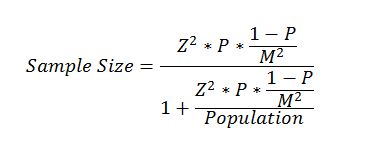
Where:
- Z = Z-score for the accepted significance level
- P = population proportion
- M = margin of error
The accepted significance level for the study was 95%, which is correspondent to the Z-score of 1.96. The proportion of population was assumed to be 0.5 and the population size was 534,000. The margin of error was accepted to be 10%, which implies that the sample size can be calculated using the following equation:

Thus, it was decided to recruit a sample of at least 97 participants to achieve the margin of error of no more than 10%. The high margin of error was accepted due to time and resource limitations of the study. The sample size requirements were approved by the research supervisor.
Sampling Method
This study utilised simple random approach to sampling to allow all the representatives of the population have the equal chance to become participants of the study. Probability sampling methods, such as simple random sampling, allow every member of the target population to have an equal chance of being involved in the research (Saunders, Lewis, and Thornhill, 2019). Probability sampling methods include four generally acknowledged subtypes, including simple random sampling, systematic random sampling, stratified sampling, and cluster sampling (Saunders, Lewis, and Thornhill, 2019). Since selection bias is a significant concern in quantitative research, it is crucial to use probability sampling to identify the factors affecting resistance to change. Simple random sampling will be used, as it allows minimizing bias from data collection. Additionally, simple random sampling was used for low possibility of mistakes during the sampling process.
Variables and Instrument
The purpose of this research was to determine correlations between four variables, among which there was one dependent variable and three independent variables. Even though demographic information was also collected from the participants, it was not used as control variables. Project management performance was used as the dependent variable, while labour productivity, technological advancement, and effect of economic growth on project management effectiveness were used as the independent variables. The study also measured the demographic variables of the sample, which included gender, age, nationality, occupation, and experience in the construction industry.
A self-created questionnaire was used to measure the variables. The questionnaire included a total of 25 questions divided into five sections. The first section of the survey included three questions that collected basic demographic data. The first question asked to state the participant’s biological gender by choosing between male and female. The second question asked the participants to select their age group from five options. The third question of the section asked the participants to select their occupation from four options, including director, supervisor, project manager, or engineer.
The second section focused at measuring project management performance using eight questions. The questions were based on seven-point Likert scale. The section asked the participants to express how much they agreed to the statements included in the section on a scale on a scale from 1 to 7, where 1 was “Strongly Disagree”, 2 was “Disagree”, 3 was “Somewhat Disagree”, 4 was “Neither Agree nor Disagree”, 5 was “Somewhat Agree”, 6 was “Agree”, and 7 was “Strongly Agree.” The questions were based on the literature review that defined several crucial characteristics of project management performance (Anderson and Lannon, 2018; Koskela and Howell, 2002a; Mir and Pinnington, 2014; Richardson and Jackson; Skitmore et al. 2020). These aspects included building partnership with various stakeholders, aligning the project goals with organisational strategy and vision, careful planning of tasks, measuring key performance indicators, timely completion of tasks, high-quality outputs, and fulfilling technical requirements (Anderson and Lannon, 2018; Koskela and Howell, 2002a; Mir and Pinnington, 2014; Richardson and Jackson; Skitmore et al. 2020). Project management performance was measured as the sum of scores for questions 4-11.
The third section aimed at measuring labour productivity in construction projects in Qatar. The section consisted of six items based on the seven-point Likert scale similar to the one utilised in the first section. The section was based on the aspects of labour productivity identified during the literature review. These aspects included perceived fairness of payment, the level of skills, the level of experience, and availability of the materials at the construction site (Alaghbari, Al-Sakkaf and Sultan, 2019; Hamza et al., 2022; Momade et al., 2020; Van Tam, Huong and Ngoc, 2018). Labour productivity was measured as the sum of scores for questions 12-17 of the self-created survey.
The fourth section consisted of four items used to measured technological advancement. The section was based on the same seven-point Likert scale that was utilised for sections 2 and 3 of the survey. The questions were based on the aspects of technological advancement derived from the literature review, which included managers’ strive to use innovative technology at the construction sites, the degree of digitalisation, and systematic training to use the latest technology. Technological advancement was measured as a sum of scores for questions 18-21.
The last section was used to measure the effect of economic growth on project management performance. The section consisted of four questions which asked the opinions of the participants concerning how much various aspects of economic growth affected project management performance. The questions were based on a seven-point liker scale, which asked to measure the effect of different aspects of economic growth on project management performance in construction projects in Qatar on a scale from 1 to 7, where ‘1’ stands for ‘Extremely Negative Impact’, ‘2’ stands for ‘Negative Impact’, ‘3’ stands for ‘Slightly Negative Impact’, ‘4’ stands for ‘Almost No Impact’, ‘5’ stands for ‘Slightly Positive Impact’, ‘6’ stands for ‘Positive Impact’, and ‘7’ stands for ‘Extremely Positive Impact.’ The effect of economic growth on project management performance was measured as the average of scores for questions 22-25 of the developed instrument.
Data Collection Process
The participants were recruited using emails to the HR managers of the construction companies. The contacts of HR managers were found from open sources online, and emails were sent to the HR managers with a brief explanation of the research goals and design. The HR managers were asked to provide a list of contacts of the participants that would be willing to participate in the research. After that, 120 people were selected randomly from the list and sent invitation emails with informed consent forms.
The data was collected automatically using Survey Monkey as the primary data collection tool. At first, it was considered to use Google Forms as the means for data collection. However, it was decided in favour of Survey Monkey, as the service provided basic data analysis tools. The recruitment emails included the link to Survey Monkey.
Data collection procedure was in accord with the requirements of the institutional ethics committee. In particular, the participants were informed that no repercussions would follow if the participants chose to decline the offer of participating in the study. All the participants were informed that they could quit the study by simply closing Survey Monkey. However, after they questionnaire was completed by the participant, there was no possibility to exclude data from analysis. No personal data was collected by the researcher, and the data was kept on the protected cloud server of the University.
Data Analysis
The data was analysed using multiple linear regression and t-test analysis. According to Saunders, Lewis, and Thornhill (2019), multiple linear regression is the most commonly used approach to testing the effect of several predictor variables on one independent variable. This research used to measure the effect of technological advancement and labour productivity on project management performance in construction industry in Qatar. Even though the purpose of the study was to measure the effect of three independent variables on the dependent variable, it was found impossible to measure economic growth using surveys. Thus, the following multiple linear regression model was assessed to test Hypotheses 1-2:
Hypothesis 3 was tested using one-sample t-test analysis. The test aimed at measuring if the mean score for the effect of economic growth on project management performance was significantly higher than ‘4’, which stood for ‘Almost No Impact’. If the mean score was significantly higher than ‘4’, the hypothesis was accepted.
Data analysis was conducted using Statistical Package for Social Sciences (SPSS) version 26. First, the data was downloaded from Survey Monkey and cleaned from incomplete questionnaires using SPSS. Second, descriptive statistics and frequency tables were created to describe the sample and summarise the variable. Third, multiple linear regression model was calculated and interpreted. Finally, one-sample t-tests run to test Hypothesis 3 and the p-value along with Cohen’s D were interpreted.
Chapter Summary
This chapter focused on the description of methods utilised to answer the research questions. The chapter established that quantitative correlation design was the most appropriate for achieving the purpose of the study. The population under analysis were employees of the construction industry in Qatar which included approximately 534,000 employees. The minimal sample size was calculated to be 97 to achieve a margin of error 10% or below. The participants were recruited using the help of HR managers of construction companies. The researcher distributed a self-created questionnaire using emails to measure three demographic variables, one dependent variable, and three independent variables. The data was analysed using multiple regression analysis and one-sample t-test in SPSS Version 26.
Results and Discussion
Introduction
This chapter focuses on the analysis and explanation of the primary data acquired from the sample of participants. First, the chapter focuses on the description of the sample in terms of distribution of gender, age, and occupation. Second, the chapter provides descriptive statistics of the variables along with the discussion of reliability and validity of the instrument. Third, the chapter introduces the results of regression analysis used to test Hypotheses 1-2. Fourth, the results of one-sample t-test are provided that was used to test Hypothesis 3. Fifth, the assumptions of regression and t-test analyses were discussed in detail. Sixth, a detailed discussion of findings against the results of previous research and LPS framework is provided. The chapter is concluded with a brief summary.
Sample Description
The final sample included 103 participants, which was above the estimated minimal sample of 97 respondents. The response rate was 82.4%, as a total of 125 invitations were sent, which is above the recommended value of 60% (Fincham, 2008). High response rates prevent the study from non-response bias, which is crucial for achieving reliable results (Fincham, 2008). All of the respondents completed the questionnaires fully, and no responses were excluded from the analysis on the basis of incompleteness. The final sample consisted of 28 (27.2%) females and 75 (72.8%) males. Around 50% of the sample were younger than 35 years of age. In particular, 19 participants were between 18 and 24 years old, 33 participants were between 25 and 34 years old, 30 participants were between 35 and 44 years old, 16 participants were between 45 and 54 years old, and five participants were 55 or older. The age distribution of the sample is visualised in Figure 1 below.
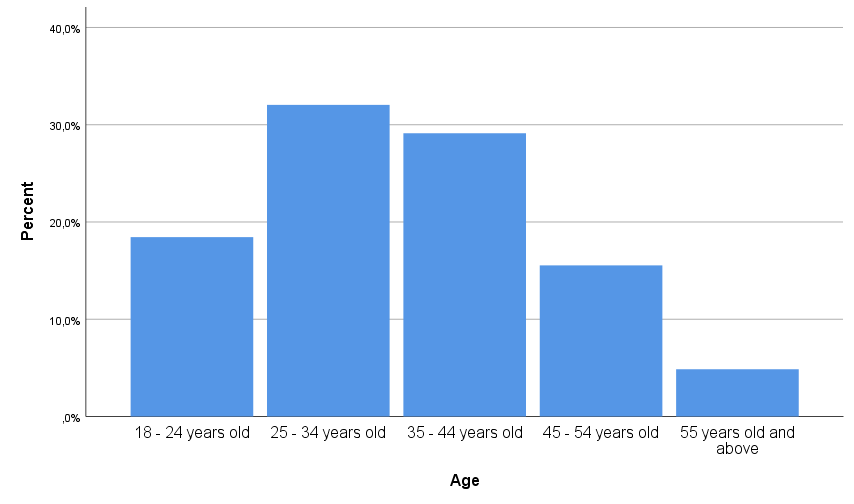
The majority of the respondents were either project managers or engineers. The distribution of the sample by occupation is provided in Table 1 below.
Table 1. Sample’s distribution by occupation
The analysis of sample characteristics demonstrated that the sample was appropriate to provide relevant responses concerning project management performance in the construction sector in Qatar.
Descriptive Statistics, Reliability, and Validity
This section focuses on the discussion of descriptive statistics of variables along with the discussion of the validity and reliability of the instrument. Even though the discussion of descriptive statistics is usually discussed separately from the reliability and validity, it was considered appropriate to unite these two sections due to the problems with reliability of one variable. Descriptive statistics of the variables is provided after validation.
The discussion of descriptive statistics in research is crucial for two reasons. On the one hand, descriptive statistics allow the reader to acquire a concise summary of variables, which can allow to spot correlations between variables (McClaive, Benson, and Sincich, 2018). On the other hand, descriptive statistics is crucial for testing the variables for normality (McClaive, Benson, and Sincich, 2018). Normality of data distribution is the central assumption in regression analysis and one-sample t-test analysis, which makes analysis of normality crucial for this study. The descriptive statistics of variables are provided in Table 2 below.
Table 2. Descriptive statistics
Project Management Performance
The scale for measuring project management performance was checked for reliability and validity. Cronbach’s alpha of the instrument was as high as 0.918, which is a sign of a very string reliability (McClaive, Benson, and Sincich, 2018). The validity of the data was checked by correlating all the items to the sum of values. Since Pearson’s correlation coefficient of all items with the sub of all items was significant, the instrument was found to have high validity. Since both reliability and validity were high, no changes were made to the variable.
Project management performance was measured using a sum of scores of eight questions based on a seven-point Likert scale. This implies that the scores for the variable had the potential to vary between 8 and 56. The mean value was 45.87 with a standard deviation of 9.75 and a median value of 50. The distribution was leptokurtic with kurtosis of 2.235 and negatively skewed with skewness of -1.65. The scores ranged between the minimum of 12 and the maximum of 56. Since the kurtosis of the distribution was above the acceptable range of -2 and 2 for normal distribution, there may be evidence of violation of the assumption of normality (McClaive, Benson, and Sincich, 2018).
Labour Productivity
The scale utilised to measure labour productivity in construction projects in Qatar was analysed in terms of validity. Cronbach’s alpha of the instrument was 0.908, which is considered extremely high (McClaive, Benson, and Sincich, 2018). Moreover, Pearson’s correlation analysis of items to the sum of items demonstrated that all the correlations of the items to the sum of items were statistically significant, which is a sign of high validity (McClaive, Benson, and Sincich, 2018). Since both reliability and validity were high, no changes were made to the variable.
Labour productivity was measured using a sum of scores of six questions based on a seven-point Likert scale. This implies that the scores for the variable had the potential to vary between 6 and 42. The mean value was 33.24 with a standard deviation of 7.92 and a median value of 36. The distribution was leptokurtic with kurtosis of 1.673 and negatively skewed with skewness of -1.51. The scores ranged between the minimum of 6 and the maximum of 42. Since neither kurtosis nor skewness of the distribution were outside the acceptable range of -2 and 2 for normal distribution, the assumption of normality was not violated for the variable (McClaive, Benson, and Sincich, 2018).
Technological Advancement
Validity and reliability of the scale was checked using Cronbach’s alpha and Pearson’s correlation analysis. Cronbach’s alpha of the instrument was as high as 0.919, which is a sign of a very string reliability (McClaive, Benson, and Sincich, 2018). The validity of the data was checked by correlating all the items to the sum of values. Since Pearson’s correlation coefficients of all items with the sub of all items was significant, the instrument was found to have high validity (McClaive, Benson, and Sincich, 2018). Since both reliability and validity were high, no changes were made to the variable.
Technological advancement was measured using a sum of scores of four questions based on a seven-point Likert scale. This implies that the scores for the variable had the potential to vary between 4 and 28. The mean value was 22.26 with a standard deviation of 5.46 and a median value of 25. The distribution was leptokurtic with kurtosis of 2.167 and negatively skewed with skewness of -1.621. The scores ranged between the minimum of 4 and the maximum of 28. Since the kurtosis of the distribution was above the acceptable range of -2 and 2 for normal distribution, there may be evidence of violation of the assumption of normality (McClaive, Benson, and Sincich, 2018).
Effect of Economic Growth
Initially, the variable was measured using four items based on a seven-point Likert scale. However, reliability analysis revealed that the Cronbach’s alpha was only 0.539, which is considered very small. In order to improve the reliability of the instrument, factor analysis was conducted to determine if the instrument measured two different phenomena. Principle component analysis demonstrated that there were two principle components in the instrument. In particular, the questions that asked to estimate the effect of inflation on project management performance was found to measure a different component from other three questions. Therefore, it was excluded from the measurement of the variable. The results of principle component analysis are provided in Table 3 below.
Table 3. Factor analysis
According to Wollie (2018), the relationship between economic growth and inflation is complicated. On the one hand, Wollie (2018) reported that inflation has a negative impact on economic growth, which implies that the higher the inflation the slower the economic growth. On the other hand, Wollie (2018) stated that there is a threshold of inflation to have an effect on economic growth, which was estimated to be 4.182%. According to Macrotrends (2022), inflation in Qatar was only 2.3% in 2021. Thus, excluding the aspect of economic growth was found to be acceptable.
After the item that asked about the influence of inflation on project management performance was deleted, only three items were used to measure the influence of economic growth. Cronbach’s alpha of the new scale was 0.799, which was considered high (McClaive, Benson, and Sincich, 2018). The validity of the data was checked by correlating all the items to the sum of values. Since Pearson’s correlation coefficients of all items with the sub of all items was significant, the instrument was found to have high validity (McClaive, Benson, and Sincich, 2018).
The scores for the effect of economic growth on project management performance had the potential to vary between 1 and 7. The mean value was 5.75 with a standard deviation of 1.03 and a median value of 6. The distribution was extremely leptokurtic with kurtosis of 4.89 and negatively skewed with skewness of -1.91. The scores ranged between the minimum of 1 and the maximum of 7. Since the kurtosis of the distribution was above the acceptable range of -2 and 2 for normal distribution, there was sufficient evidence of violation of the assumption of normality (McClaive, Benson, and Sincich, 2018).
Hypothesis Testing
Hypothesis testing was conducted using regression analysis and one-sample t-test analysis. This section provides description of results of these two tests with a brief conclusion if the hypothesis should be accepted or rejected. The conclusions were drawn based on the confidence level of alpha = 0.05. Additionally, Cohen’s d was analysed to measure the effect size of economic growth on project management performance.
Regression Analysis
Regression analysis was used to measure two hypotheses. In particular, multiple linear regression model allowed the researcher to measure the effect of labour productivity and technological advancement on project management performance. The results of regression analysis are provided in Tables 4-5 below.
Table 5. Model summary
Table 6. Estimation of coefficients
The results demonstrated that the regression model was statistically significant with adjusted R2 = 0.633 (F = 89.13, p < 0.001). This implies that fluctuations of labour productivity and technological advancement could explain 63.3% of the changes in project management performance. The analysis of coefficients demonstrated that both Hypotheses 1 and 2 should be accepted, as coefficients for labour productivity and technological advancement were statistically significant.
Hypothesis 1 stated that there was a significant relationship between labour productivity and the enhanced project management performance in the construction industry in Qatar. The results of regression analysis demonstrated that the coefficient of labour productivity was statistically significant (t = 5.57; p < 0.001). Since the p-value was below the threshold of alpha = 0.05, the hypothesis was accepted. The analysis demonstrated that technological advancement had a significant positive effect on project management performance.
Hypothesis 2 state that there was a significant relationship between technological advancement and the enhanced project management performance in the construction industry in Qatar. The results of regression analysis demonstrated that the coefficient of technological advancement was statistically significant (t = 3.9; p < 0.001). Since the p-value was below the threshold of alpha = 0.05, the hypothesis was accepted. The analysis demonstrated that labour productivity had a significant positive effect on project management performance.
One-Sample T-Test
One-sample t-test was used to compare the mean of the effect of economic growth on project management performance in construction sector in Qatar to the value of ‘4’. According to the last section of the developed instrument, ‘4’ stood for ‘Almost No Impact’. Therefore, it was assumed that if the mean score of the three items was equal to ‘4’, economic growth would have no effect on project management performance. Therefore, the hypotheses for the t-test were the following:
H0: The mean value of the effect of economic growth on project management performance is equal to ‘4’.
HA: The mean value of the effect of economic growth on project management performance is not equal to ‘4’.
The results of t-test are summarised in Table 7 below.
Table 7. One-sample t-test results summary
The results demonstrated that the mean effect of economic growth on project management performance in construction sector in Qatar (M = 5.75; SD = 1.03) was above the value of ‘4’ (t(102) = 17.24; p < 0.001). The 95% confidence interval for the mean difference was [1.55; 1.95]. Since the p – value was below the threshold of 0.05, the null hypothesis was rejected, and the alternative hypothesis was accepted.
The effect size was also calculated for the t-test to determine how meaningful was the difference in means tested using one-sample t-test. Unfortunately, SPSS Version 26 does not allow to calculate effect sizes of t-tests. Therefore, Cohen’s d was calculated using the following formula:
According to McClaive, Benson, and Sincich (2018), Cohen’s d value above 0.8 are seen large effect sizes. Therefore, the effect size of economic growth on project management performance in construction sector was found to be very high.
Testing for Assumptions
There several assumptions of statistical test that should be followed to ensure the reliability of test results. According to Stephan, Levine, and Szabat (2020), the assumptions of one-sample t-test include normality, independence of observations, absence of significant outliers, and the variable should be continuous. The assumptions of multiples regression analysis include normality, linearity, absence of multi-collinearity, and homoscedasticity (Stephan, Levine, and Szabat, 2020). This section includes the detailed discussion of these assumptions except for the assumption of independence of observations, absence of outliers, and characteristics of the variable. These three assumptions were not violated, as the data collection method did not suppose dependent observations, all the variables were based on a continuous scale, and the analysis of descriptive statistics revealed no significant outliers.
Normality
One of the central assumptions of both regression and one-sample t-test analyses is normality. According to McClaive, Benson, and Sincich (2018), there are several ways to assess normality of distribution. One of simplest methods is using kurtosis and skewness. If the absolute value of either skewness or kurtosis is above ‘2’, there is a possibility that the data is not normally distributed (McClaive, Benson, and Sincich, 2018). At the same time, McClaive, Benson, and Sincich (2018) state that if skewness and kurtosis are below 3, there is still a strong probability of distribution being normal.
The assumption of normality was discussed Section 4.3 of this thesis. According to descriptive statistics provided in Table 2 above, skewness and kurtosis of project management performance, labour productivity, and technological advancement were below the threshold of 3. Therefore, it may be considered that the assumption of normality was not violated for these three variables. However, kurtosis of the effect of economic growth on project management performance was as high as 4.89, which is a clear sign of violation of normality according to McClaive, Benson, and Sincich (2018). At the same time, Hair et al. (2015) stated that the threshold for normality is the absolute value of 2 for skewness and absolute value of 7 for kurtosis. Thus, according to Hair et al. (2015), the assumption of normality was not violated for the effect of economic growth on project management performance.
In order to settle the controversy between the assumptions, it was decided to create a histogram for the effect of economic growth on project management performance. The histogram is provided in Figure 2 below.
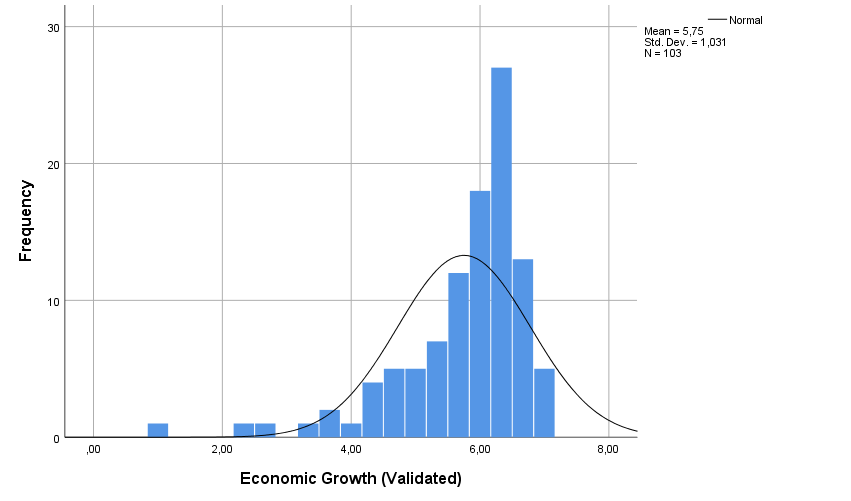
The graphical analysis demonstrates, that even though the distribution of the variable differs from the normal distribution curve, the overall shape of the distribution is close to normal. Therefore, it was decided that the assumption of normality was no violated for the variable.
Linearity
Linearity is an assumption of regression analysis, which states that the relationships between the independent variables and the dependent variable should be linear. This assumption implies that when any of the independent variables is plotted against the dependent variable, the data points should be scattered along a straight line. Two plots were created to estimate the relationships between the variables, which are demonstrated in Figure 3 below. The results demonstrated that the assumption of linearity was not violated, as the data points seemed to be scattered along a straight line in both graphs.

Multi-Collinearity
Absence of multi-collinearity is a crucial assumption, which implies that there are no strong inter-relationships between the dependent variables. If two or more variables have a strong correlation between them, they may fail to provide unique insight about the dependent variable (Stephan, Levine, and Szabat, 2020). In other words, if there is a very strong correlation between variables, they may essentially measure the same thing, which leads to variable redundancy. There two methods of testing for multi-collinearity, including variance inflation factor (VIF) and Pearson’s correlation analysis (McClaive, Benson, and Sincich, 2018). According to Stephan, Levine, and Szabat (2020), if Pearson’s correlation coefficient between two variables is below a threshold of 0.8, multi-collinearity is not issue. Since the Pearson’s correlation coefficient was 0.743 (p < 0.001), multi-collinearity did not appear a significant concern for the analysis. Moreover, the VIF score was below a threshold of ‘5’, which also signals about the absence of multi-collinearity. Therefore, it may be concluded that the assumption of the absence of multicollinearity was not violated.
Homoscedasticity
The final assumption of regression analysis homoscedasticity, which is equality of distribution of the residuals. The assumption was tested by plotting regression standardised residuals against regression standardised predicted values. The plot is provided in Figure 4 below. According to the plot, there is no clear evidence that the distribution of standardised residuals is heteroscedastic. Therefore, it was considered that the assumption of homoscedasticity was not violated.
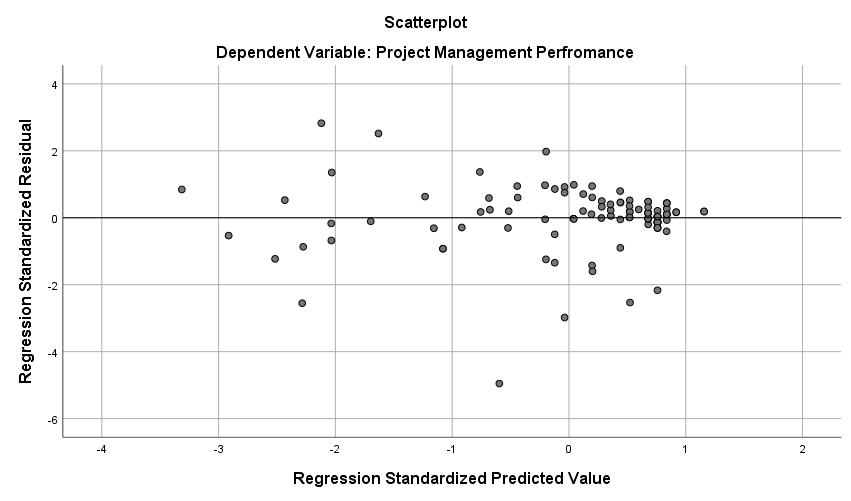
Discussion
This section focuses on the discussion of the results of the research against the findings of previous research and LPS, which was considered the central theoretical framework utilised by this research. The section is subdivided into three subsections according to the number of hypotheses.
Hypothesis 1
The first hypothesis focused on the discussion of relationships between labour productivity and project management efficiency in construction sector in Qatar. Regression analysis demonstrated that the hypothesis should be accepted, demonstrating that there was a significant correlation between the two variables. Since the coefficient for labour productivity was positive, it may be stated that the higher the productivity of labour the better the project management performance. In other words, it may be concluded that labour productivity enhances project management performance in construction sector in Qatar.
Previous research did not touch upon the labour productivity as a factor contributing to project management performance. Therefore, this study is unique, as it provides valuable insights concerning the effect of labour productivity on project management. Previously, Momade and Hainin (2019) stated that employee motivation is crucial for improving project management efficiency. Momade and Hainin (2019) stated that there were five motivating factors, including achievement, recognition and rewards, interest in work, involvement in decision-making, and adequate training and development, that helped to enhance project management performance. At the same time, there were several demotivating factors, including poor work condition, poor policies, lack of effective communication, poor relationships at work, and lack of appreciation (Momade and Hainin, 2019).
The concept of labour productivity goes beyond motivational and demotivational factors. Hamza et al. (2022) stated that even though motivation contributes to labour productivity, there are other factors that affect it. Momade et al. (2020) determined 19 significant factors that affected labour productivity, which included demographic variables, on-sight training, and the required level of quality. Work experience, job category, training, nationality, skills, age, marital status, accidents during construction, inadequate construction methods, and violation of safety laws have significant impact on labour productivity (Momade et al., 2020). Alaghbari, Al-Sakkaf and Sultan (2019) stated that gross average earning is also a crucial metric for labour productivity. This implies that the present study provided crucial insights for project managers in construction industry in Qatar to enhance their project management performance.
Since there was a positive correlation between labour productivity and project management performance, it may be assumed that if there is a positive correlation between all the aspects of labour productivity and project management performance. Therefore, if managers want to improve their project management performance, they should focus on improving various factors that contribute to it. Momade et al. (2020) ranked the 19 factors from the most impactful to the least impactful. The most impactful were lack of work experience, job category, and education and training (Momade et al., 2020). These top three factors contributing to labour productivity demonstrate that project managers should select workers that have adequate training and experience in the required job category to improve project management performance.
The results of this study are also in accord with the LPS framework. Manager’s role in LPS is to ensure that the actor has all the resources to complete the task instead of simply dispatching tasks to work stations (Koskela and Howell, 2002a). Alaghbari, Al-Sakkaf and Sultan (2019) stated that labour efficiency is highly dependent on the availability of resources, which implies that project management efficiency is dependent on labour productivity. Moreover, LPS associated with lean principles and avoiding a command-and-control (Aslam, Gao and Smith, 2021). In other words, according to LPS, engagement of actors in the decision-making process is crucial for improving project management performance. Since Momade et al. (2020) stated that engagement is a crucial contributor to labour productivity, it may be concluded that there is a positive correlation between project management performance and labour productivity.
Hypothesis 2
The second hypothesis stated that there was a significant correlation between technological advancement and project management performance. Regression analysis demonstrated that there was a as significant correlation between technological advancement and project management performance. Since the coefficient for the variable was positive, it may be concluded that technological advancement positively affected project management performance. In other words, the higher the technological advancement score, the more enhanced was project management performance. The results of this research are unique, as previous research did not focus on the effect of technological advancement on project management performance in construction sector in Qatar.
The results of this study are in accord with previous research. Zhu et al. (2019) stated that innovative technology has both direct and indirect impact on the construction project management, as it affects resource use. Innovative equipment can save energy, which reduces the cost of projects (Zhu et al., 2019). Project management performance is measured by a wide variety of metrics, including cost efficiency (Mir and Pinnington, 2014). Since innovative technology improves cost efficiency, it also enhances project management performance. Additionally, previous research demonstrated that technological development improves the value chain in construction industry (Hossain and Nadeem, 2019). Value chain improvements are associated with enhancement of quality, quantity, and timeliness of outputs (Hossain and Nadeem, 2019). Therefore, according to Anderson and Lannon (2018), there is a strong link between technological advancement and project management performance in the construction sector. This research increased the generalisability of previous research by confirming the correlation in the construction sector in Qatar.
Previous research also explains how project management performance can be enhanced by improving technological innovation. In particular, Zhu et al. (2019) recommend that project managers in construction sector should always search for technology that can improve the efficiency of energy use. Such innovative equipment can help to reduce cost and, therefore, improve project management performance (Zhu et al. et al, 2019). Moreover, mangers are recommended to utilise equipment that can enhance control over outputs (Hossain and Nadeem, 2019). Such investments can improve project management performance in construction sector in Qatar.
Technological advancement is also crucial for construction projects from LPS model’s viewpoint. Lagos, Herrera, and Alarcón (2017) stated that technological advancement enhances the LPS model through standardisation of the planning and control process, use of indicators to assess compliance with planning, critical analysis of information, correct definition of work packages, using an easy-to-understand and transparent master plan, and systematic analysis and removal of constrains. Thus, it may be concluded that the findings of this paper are in accord with previous research and the LPS model.
Hypothesis 3
The third hypothesis focused on assessing the effect of economic growth on project management performance. The results of the single-sample t-test demonstrated that economic growth had a significant effect on project management performance. The average score of 5.7 for the variable demonstrates that economic growth positively affected project management performance. In particular, it was concluded that GDP, population growth, and economic stability had a positive effect on project management performance. The results of this research are unique as no previous studies focused on assessing the effect of economic growth on project management performance in the construction sector in Qatar. Moreover, no previous research focused on the relationship between these two variables in any context.
This study excluded inflation from the analysis, even though inflation is a crucial component of economic growth. The basis for exclusion of the aspect was the research by Wollie (2018), which stated that there was a threshold of inflation to have an effect on economic growth of 4.182%. We decided to perform single-sample t-test analysis for the effect of inflation project management effectiveness in construction sector in Qatar. The results revealed that the mean score for the variable (M = 2.95, SD = 1.6) was below 4 (t(102) = p < 0.001) with a mean difference of 1.05). This implies that, according to this study, inflation had a slight negative effect on project management performance in construction sector in Qatar.
The results of the research are consistent with the LPS model. Project management is closely associated with constant assessment of risks and making decisions to minimise these risks (Aslam, Gao and Smith, 2021; Heigermoser et al., 2019; Koskela and Howell, 2002a; Tayeh et al., 2019). Economic factor is seen as one of the contributors to project management risks, as economic recession can lead to decreases in investment in the construction sector (Alsamara et al., 2019). In other words, economic factors may contribute to the availability of resources used to complete the project’s tasks in a timely matter. According to LPS, the project manager’s main purpose is to ensure that actors have all the resources they need to perform their duties on time (Heigermoser et al., 2019). Therefore, economic growth contributes to the managers’ ability to attend to their purpose.
Qatar experienced a significant economic growth due to economic growth associated with the FIFA World Cup in Qatar (Al-Dosari, 2020). As a result, the construction industry began to thrive due to the rapid growth of demand for new construction projects and overall growth of construction industry (Al-Dosari, 2020). The growth of the sector led to an increased demand for workers, which increased migration to Qatar and rapid population growth (Al-Tamimi and Al-Ghamdi, 2020). However, during the COVID-19 pandemic, the economic recession led to freezing numerous construction projects, which had a negative effect on project management performance in the industry (Alenezi, 2020). Thus, the findings of this research are in accord with the recent history of Qatar.
Chapter Summary
This chapter focused on the description of the research results and their discussion against the current body of knowledge and the LPS model. The results demonstrated that all three hypotheses should be accepted. This implies that labour productivity, technological advancement, and economic growth had a positive effect on project management performance in the construction industry. The analysis of assumptions revealed no significant violations; however, a possibility of violation of the assumption of normality for one of the variables was found. The results of this research are consistent with previous findings and the LPS model. At the same time, the study is unique, as it studied the effect of the three factors contributing to project management effectiveness in the construction sector in Qatar.
Conclusion, Recommendations, and Limitations
Introduction
This final chapter of the thesis draws the conclusions from the study and providing recommendations for project managers and for future research. The chapter starts with the discussion of limitations of the study to acknowledge borders of applicability of findings and describe the drawbacks in design that could potentially lead to bias. After that, the chapter provides answers to the research questions by summarising the results of the study that can answer them. Finally, the chapter provides recommendations for future research based on the limitations of the study. The chapter is concluded with a brief summary.
Limitations
The discussion of limitations is crucial for any research, as it helps the reader to look critically at the research findings (Hair et al., 2015). Acknowledgement of limitations is known as demonstration of aspects of methodology and scope that influenced the results of the analysis (Hair et al., 2015). Understanding limitations of a study is crucial to provide suggestions for further research to improve reliability, validity, and generalizability of findings (Creswell, 1994). However, discussion of limitations is known to be a subjective process, as the researcher needs to evaluate the impact of the limitations on the results of the analysis, which is highly dependent on the researcher’s skills and experience (Creswell, 2007).
The central limitation of the study is its generalizability. The research focused on the discussion of factors that enhance project management performance in the construction sector in Qatar. Even though the findings of this research are in accord with the results of previous studies in some cases, managers should apply the results of this study to other context with caution. The central reason for the limitations is that the construction sector in Qatar has its unique characteristics that other sectors in other countries may not have. The construction sector in Qatar is characterised by increased number of immigrants as workers (CEIC, 2017). Moreover, the sector may be affected by the country’s political and economic conditions. Therefore, the factors discussed in this study may have a different effect on project management performance in other contexts.
The second limitation that should be acknowledged is sample characteristics. On the one hand, the sample included only relevant respondents. In particular, the sample included directors, supervisors, project managers, and engineers working in the construction industry in Qatar, which implies that the collected data is a reliable source of data. On the other hand, the sample size imposes significant limitations on the reliability of findings due to a high margin of error. According to Survey Money (no date), the sample size is associated with a margin of error of 10%, which is considered to be high (McClaive, Benson, and Sincich, 2018). In other words, the sampling strategy can impose significant limitations to the study.
The third limitation is imposed by the time limitations of the research. The timeframe and the schedule of the research was guided by the University rules. If the researcher had more time to conduct the research, the results may have been different, as the research could have compiled a more detailed literature review and analysis of data. However, it was estimated that the impact of time limitation was small.
Fourth, the results of the research are limited by the quantitative nature of the study. The purpose of this research was to determine which factors enhanced project management performance in the construction sector in Qatar. The results of research revealed three factors that contribute to project management performance in the sector. However, this research did not provide unique information concerning the reasons for these factors affecting project management performance in the sector. In other words, this study did not aim at answering why these factors affect project management performance. All the explanations provided in this research were based on findings of previous research and the LPS model instead of being based on primary data.
Fifth, this research conducted assessment of primitive quantitative models, which did not allow in-depth understanding of factors affecting project management performance. The quantitative model included only tow independent variables without any controls. However, project management performance is a very complicated concept that consists of numerous aspects and many other variables may affect project management performance (Mir and Pinnington, 2014).
Finally, this study is limited by the ability and experience of the researcher. Even though the researcher has significant experience in project management in the construction sector in Qatar, the ability to conduct research was limited. This study was the biggest research project that the researcher has accomplished out of few research projects in the lifetime. Therefore, mistakes may have occurred in the research design or execution. However, since the research process was guided by an authorised supervisor, the effect of the author’s lack of experience in conducting research was minimal.
RQ1: Factors Affecting Project Management Performance
The first research question was focused on determining the factors that enhance project management performance in the construction industry in Qatar. This study created two quantitative models that tested three hypotheses concerning the possible factors that affected project management performance based on the findings of previous research. The results of the analysis of the models confirmed all three hypotheses, which made a significant contribution to understanding of project management performance in the construction sector in Qatar. The results of the analysis were explained using the LPS model and previous research.
First, the results of this research demonstrated that labour productivity had a significant positive effect on project management performance. This was explained by the fact that project management performance is measured by the quality and quantity of outputs of the construction products (Koskela and Howell, 2002a). Labour productivity is the amount of economic value per unit of labour; therefore, there is a close correlation between labour productivity and project management performance on a conceptual level (Alaghbari, Al-Sakkaf and Sultan, 2019; Hamza et al., 2022; Momade et al., 2020; Van Tam, Huong and Ngoc, 2018). Second, the study demonstrated that technological advancements enhanced project management performance. The general idea behind the correlation was that innovative technology allow better control over inputs and outputs (Hossain and Nadeem, 2019). As a result, the quality of construction increases and the amount of resources used to conduct the project decreases. Finally, this study demonstrated that economic growth had a positive impact on project management performance in the construction sector in Qatar. This correlation was explained by the fact that economic recessions may reduce the ability of project managers or acquire resources needed to ensure a smooth flow of the project. Thus, a total of three significant predictors of project management performance in construction sector in Qatar were discovered by this research.
The results of the analysis provided in this study were consistent with the results of previous research and the LPS model. However, it should be noted that this research did aim at explaining how the factors interact with the dependent variable and with each other. The aim of this research was not focused on achieving the depth. Instead, the study intended to achieve breadth of knowledge and establishing facts. Therefore, the explanations provided in the study are considered a contribution of this research to the current body of knowledge.
RQ2: Recommendations for Enhancing Project Management Performance
The second research question was centred at providing recommendations for enhancing project management performance in the construction sector in Qatar. We provide a set of recommendations based on the results of his study along with the findings of previous research.
- Improve labour productivity. This research demonstrated that there was a significant positive correlation between project management performance and labour productivity in the construction industry in Qatar. Therefore, project managers in the industry can focus on improving labour productivity to enhance project management performance. Momade et al. (2020) determined several factors that can be improved to enhance labour productivity, including work experience, job category, training, nationality, skills, age, marital status, accidents during construction, inadequate construction methods, and violation of safety laws. This implies that the project mangers are recommended to select the employees and carefully so that they have the needed experience and training to accomplish their tasks. Moreover, managers should minimise the occurrence of on-sight accidents and avoid violating safety laws.
- Use the latest technology. This study demonstrated that there was a significant positive relationship between technological advancement and project management performance. In other words, an increase in the latest technology use can lead to improved project management outcomes. Recent studies recommend to use technology for controlling the inputs and outputs of construction projects (Hossain and Nadeem, 2019). In particular, Zhu et al. (2019) recommend to use the latest technology to improve energy efficiency in the construction sights. However, it should be noted that the use of technology does not guarantee improved project management performance. Project manager should assess the cost of new equipment and the potential benefits it can bring before buying and using new equipment. Additionally, the LPS model presupposes that project managers conduct the needed training among employees so that the equipment can be used effectively (Heigermoser et al., 2019).
- Consider economic growth. The analysis of this study demonstrated that there was a positive link between economic growth and project management performance in the construction industry in Qatar. Since project managers cannot affect economic growth in the country, they can only plan projects in accord with the forecast of the economic situation in the country. Any projected economic downturns are expected to lead to problems with supply chains and resource availability (Al-Dosari, 2018; Al-Tamimi and Al-Ghamdi, 2020; Lordkipanidze, 2020). Therefore, project managers should account for the possible disruptions at the stage of planning.
Recommendations for Future Research
The recommendations for future research are listed below. These recommendations are based on the limitations of the study.
- Conduct similar studies in different contexts. The results of this study can be applied only to construction projects in Qatar, which is a significant limitation to the generalizability of findings. At the same time, the research has established effective methods for answering the research questions. Therefore, this research can be replicated for other countries and industries to increase the generalizability of findings.
- Increase the sample size. The samples size the study used for acquiring primary data is associated with a high margin of error of 10%. A sample size of 384 participants can improve the margin of error to 5%, which is crucial for acquiring more reliable results (Survey Monkey, no date). However, having a larger sample is associated with increased time and resources needed to conduct research, which should be accounted for in future attempts to improve the results.
- Allow more time to conduct research. This study is based on a literature review of 26 reputable scholarly sources. The limitation in the number of sources was associated with a significant time constraint imposed by the University policy. However, if researchers dedicate more time for the literature review and data collection to improve the reliability of findings.
- Create more complicated statistical models to account for indirect correlations. The concept of project management performance is very complicated, as it is affected by numerous factors (Mir and Pinnington, 2014). Thus, there may be more predictors that should be assessed complicated correlations among the predictors. For instance, Alaba (2019) stated that technological advancement affects labour productivity, which, in turn affects project management performance. In other words, labour productivity may act as a mediator in the relationship between project management performance and technological advancement. This relationship may be tested in future research.
- Conduct qualitative studies to explain the results of this research. Even though this research confirmed that three factors can enhance project management performance, it did not explain why these factors affected the dependent variable. Therefore, conducting a qualitative study on the matter can help to explain the results of this research. In particular, future research can recruit a small sample of project managers and conduct semi-structured interviews to collect primary data on the subject of interest. After that, thematic analysis of data can be conducted to extract the reasons why labour productivity, economic growth, and technological advancement affect project management performance.
Chapter Summary
This chapter aimed at summarising all the conclusions of the study. First, the chapter established the limitations of the study, which included limited generalisability, small sample size, timeframe, simplicity of the statistical models, and experience and skills of the researcher. After that, the chapter focused on answering the research questions. First, it was established that labour productivity, technological advancement, and economic growth had a significant positive effect on project management performance in the contractions sector in Qatar. After that, the chapter provided and justified methods recommendations for enhancing project management performance in the construction sector in Qatar. The chapter was concluded with suggestions for future research based on the limitations of this study.
References
Al-Dosari, K. (2018) Assessing the Impacts of Mega Sporting Events on Tourism: A Case of the 2022 FIFA World Cup in Qatar. Economic Policy [online], v.36 (2), pp.292-301. Web.
Al-Khulaifi, A.S. (2018) An empirical study on inflation and economic growth in Qatar. International Journal of Economics and Financial Research [online], v.4 (9), pp.292-296. Web.
Al-Tamimi, A. and Al-Ghamdi, S.G. (2020) Multi-scale integrated analysis of societal and ecosystem metabolism of Qatar. Energy Reports [online], v.6, pp.521-527.
Alaba, O.V. (2020) Technological Advancement Strategy and Performance of Listed Construction Company in Nigeria. International Journal of Trend in Scientific Research and Development [online], v.4 (5), pp.1080-1088. Web.
Alaghbari, W., Al-Sakkaf, A.A., and Sultan, B. (2019) Factors affecting construction labour productivity in Yemen. International Journal of Construction Management [online], v.19 (1), pp.79-91.
Alenezi, T.A.N. (2020) Covid-19 causes of delays on construction projects in Kuwait. IJERGS [online], v.8 (1), pp.6-9.
Alsamara, M., Mrabet, Z., Jarallah, S. and Barkat, K. (2019) The switching impact of financial stability and economic growth in Qatar: Evidence from an oil-rich country. The Quarterly Review of Economics and Finance [online], v.73, pp.205-216.
Anderson, K. and Lannon, J. (2018) Project management performance assessment in the non-profit sector. Project Management Research and Practice [online], v.5, pp.1-20. Web.
Aramali, V., Gibson Jr, G.E., El Asmar, M. and Cho, N. (2021) Earned value management system state of practice: Identifying critical subprocesses, challenges, and environment factors of a high-performing EVMS. Journal of Management in Engineering [online], v.37 (4), p.04021031.
Aslam, M., Gao, Z. and Smith, G. (2020) Development of innovative integrated last planner system (ILPS). International Journal of Civil Engineering [online], v.18 (6), pp.701-715.
Bougie, R. and Sekaran, U. (2019) Research Methods for Business: A Skill Building Approach. United Kingdom: Wiley.
Burghate, M. (2018) Work breakdown structure: Simplifying project management. International Journal of Commerce and Management [online], v.3 (2), pp.453-461. Web.
CEIC (2017) Number of Employees: Building and Construction [online]. Web.
Creswell, J.W. (1994) Research design: Qualitative and quantitative approaches. Thousand Oaks: Sage.
Creswell, J.W. (2007) Qualitative inquiry & research design. Thousand Oaks: Sage Publications.
Fincham, J. E. (2008) Response rates and responsiveness for surveys, standards, and the Journal. American Journal of Pharmaceutical Education [online], v.72 (2), p. 43.
Hamza, M., Shahid, S., Bin Hainin, M.R. and Nashwan, M.S. (2022) Construction labour productivity: review of factors identified. International Journal of Construction Management [online], v.22 (3), pp.413-425.
Heigermoser, D., de Soto, B.G., Abbott, E.L.S. and Chua, D.K.H. (2019) BIM-based Last Planner System tool for improving construction project management. Automation in Construction [online], v.104, pp.246-254.
Hair J. F. et al. (2015). The Essentials of Business Research Methods. United Kingdom: Taylor & Francis.
Hossain, M.A., and Nadeem, A. (2019). Towards digitising the construction industry: State of the art of construction 4.0. Proceedings of the ISEC [online], v.10.
Koskela, L. and Howell, G. (2002a) The theory of project management: Explanation to novel methods. Proceedings IGLC [online], v.10 (1), pp.1-11. Web.
Koskela, L.J. and Howell, G. (2002b) The underlying theory of project management is obsolete. Proceedings of the PMI research conference [online], v.10 (1), pp.293-302. Web.
Lagos, C., Herrera, R., and Alarcón, L. F. (2017) Contributions of information technologies to last planner system implementation [online]. Web.
Lordkipanidze, R. (2020) Recommendations to the richest (on per capita) country-Qatar for save the successful economic results. International Charity Scientific-Research Partnership of Physical Persons [online], pp.1-8.
Macrotrends (2022) Qatar Inflation Rate 1980-2022 [online]. Web.
Maliszewska, M., Mattoo, A., and Van Der Mensbrugghe, D. (2020) The potential impact of COVID-19 on GDP and trade: A preliminary assessment. World Bank policy research working paper [online], working paper 9211. Web.
McClaive, J., Benson, G. and Sincich, D. (2018). Statistics for business and economics. UK: Pearson.
Mir, F.A. and Pinnington, A.H. (2014) Exploring the value of project management: linking project management performance and project success. International Journal of Project Management [online], v.32 (2), pp.202-217.
Momade, M.H., Shahid, S., Hainin, M.R.B., Nashwan, M.S. and Tahir Umar, A. (2020) Modelling labour productivity using SVM and RF: a comparative study on classifiers performance. International Journal of Construction Management [online], pp.1-11.
O’Gorman, K. and Macintosh, R. (2015) Research Methods for Business & Management: A Guide to Writing Your Dissertation. United Kingdom: Goodfellow Publishers Limited.
Richardson, G. and Jackson, B. (2018) Project Management Theory and Practice. Auerbach Publications.
Saunders, M., Lewis, P., and Thornhill, A. (2019) Research Methods for Business Students. Brazil: Pearson.
Skitmore, M., Xiong, B., Xia, B., Masrom, A. and Newton, S. (2020) Relationship between contractor satisfaction and project management performance. Construction Economics and Building [online], v.20 (4), pp.1-24.
Stephan, D., Levine, D. M., and Szabat, K. A. (2020) Statistics for Managers Using Microsoft Excel, Global Edition. Germany: Pearson Education Limited.
Survey Monkey (no date) Sample size calculator [online]. Web.
Tayeh, B.A., Al Hallaq, K., Zahoor, H. and Al Faqawi, A.H. (2019) Techniques and benefits of implementing the last planner system in the Gaza Strip construction industry. Engineering, Construction and Architectural Management [online], v.26 (7), pp.1424-1436.
Thoha, N. and Avandana, I. M.N.W. (2020) Project Managers’ Leadership Styles and Their Effects on Project Management Performance. Pertanika Journal of Social Sciences & Humanities [online], v.28 (2). Web.
Umar, T. (2022) The impact of COVID-19 on the GCC construction industry. International Journal of Service Science, Management, Engineering, and Technology (IJSSMET) [online], v.13 (2), pp.1-17.
Van Dam, N., Huong, N.L., and Ngoc, N.B. (2018) Factors affecting labour productivity of construction worker on construction site: A case of Hanoi. Journal of Science and Technology in Civil Engineering (STCE)-HUCE [online], v.12 (5), pp.127-138.
Verbeke, A., Nielsen, B. B., Eden, L. (2019) Research Methods in International Business. Germany: Springer International Publishing.
Wollie, G. (2018) The Relationship between Inflation and Economic Growth in Ethiopia. Budapest International Research and Critics Institute-Journal [online], v.1 (3), pp. 264-271. Web.
Zhu, W., Zhang, Z., Li, X., Feng, W. and Li, J. (2019) Assessing the effects of technological progress on energy efficiency in the construction industry: A case of China. Journal of Cleaner Production [online], v. 238, p.117908.
Appendix: Screenshots from SPSS
Sample Description
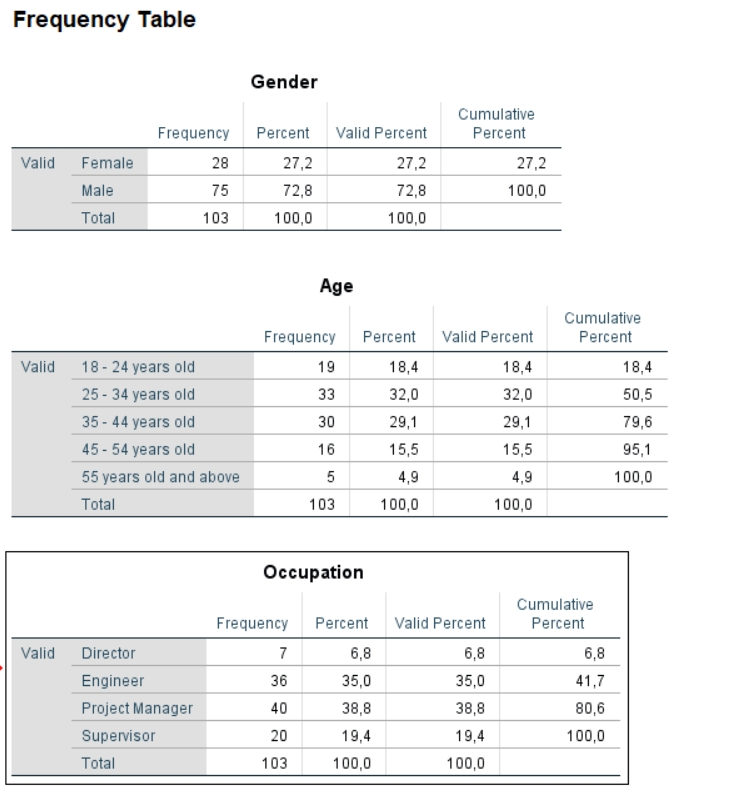
Descriptives
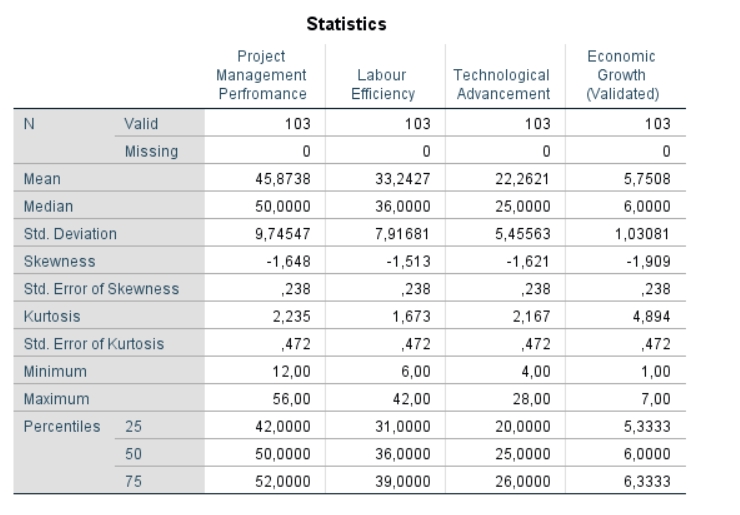
Validity and Reliability of Project Management Performance
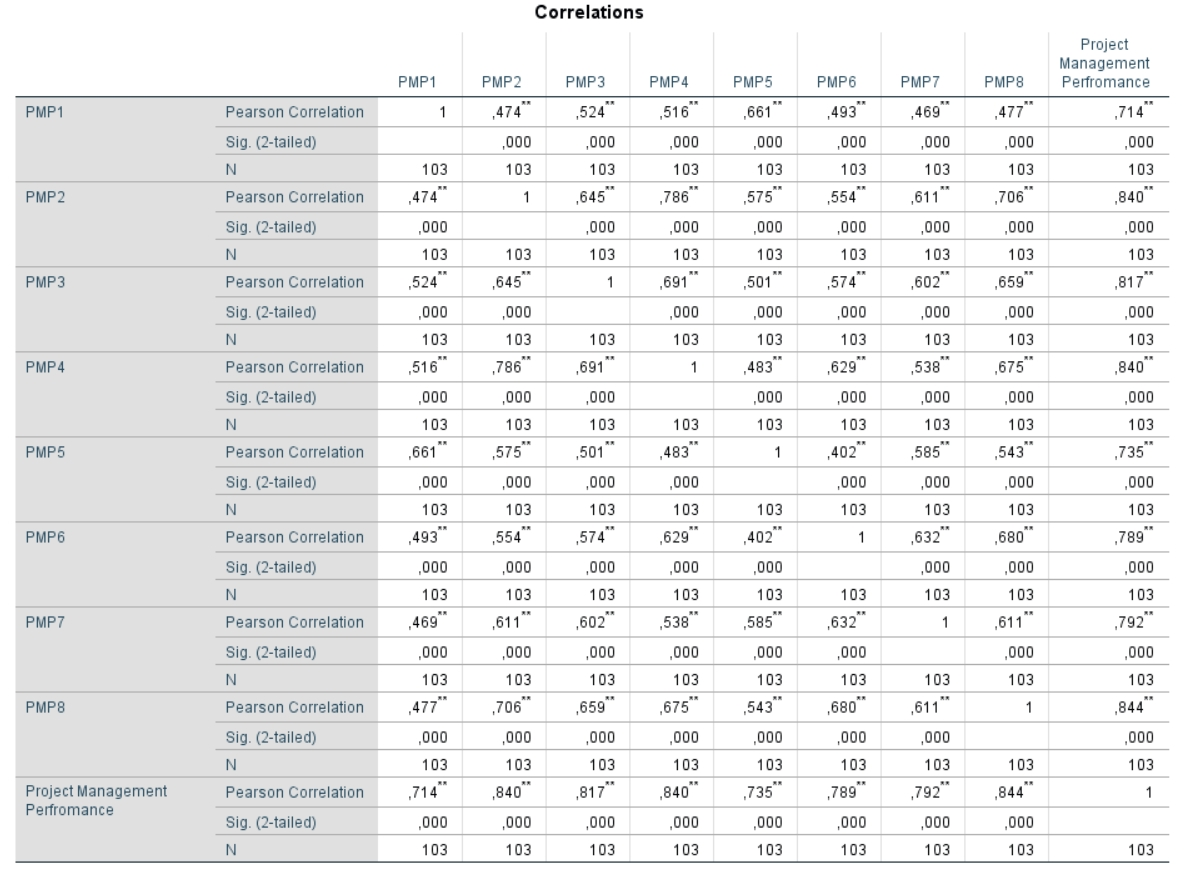
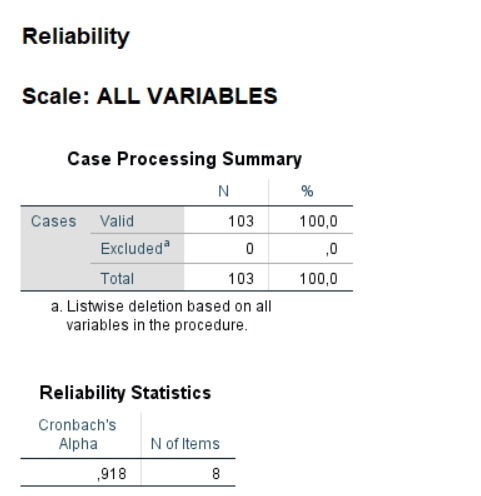
Validity and Reliability of Labour Productivity
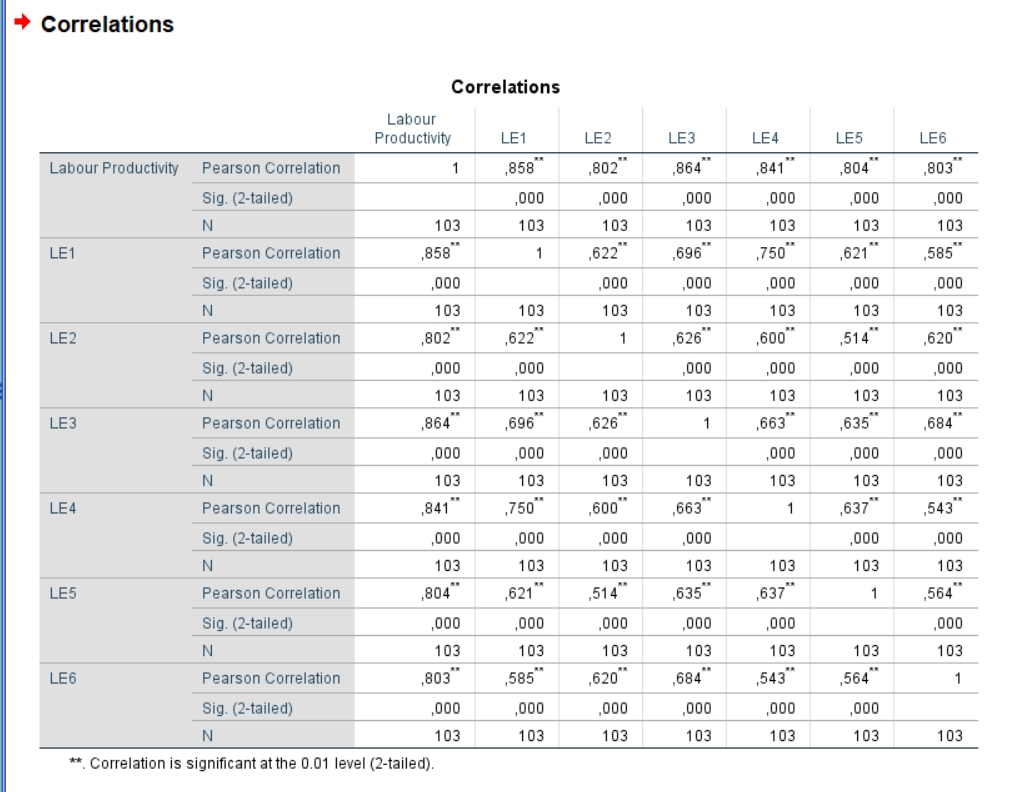
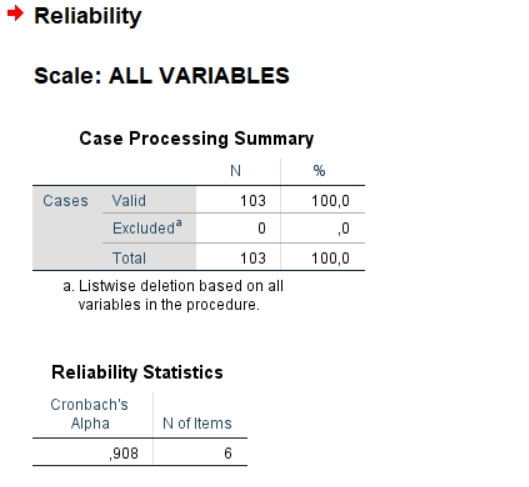
Validity and Reliability of Technological Advancement
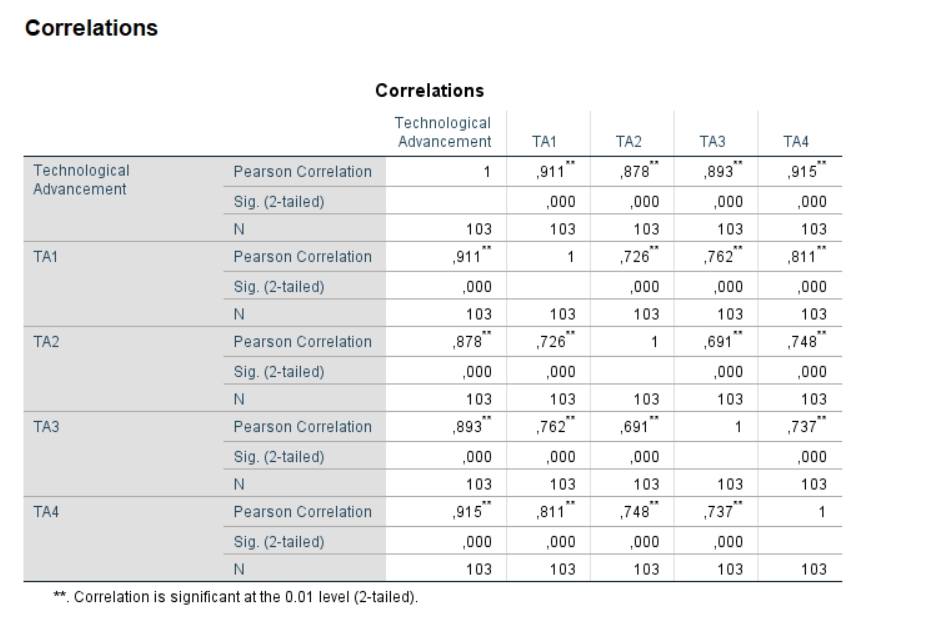
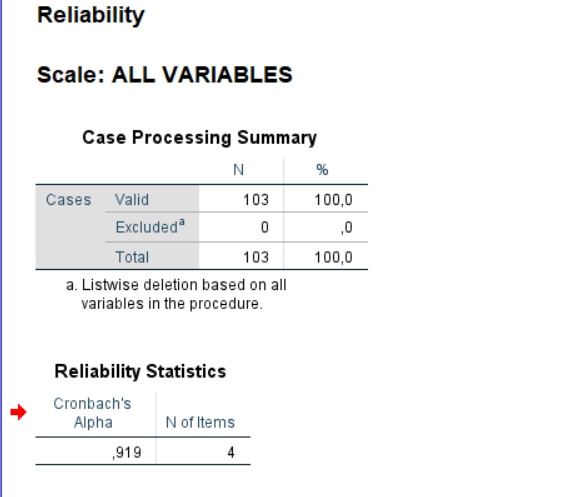
Validity and Reliability of Economic Growth
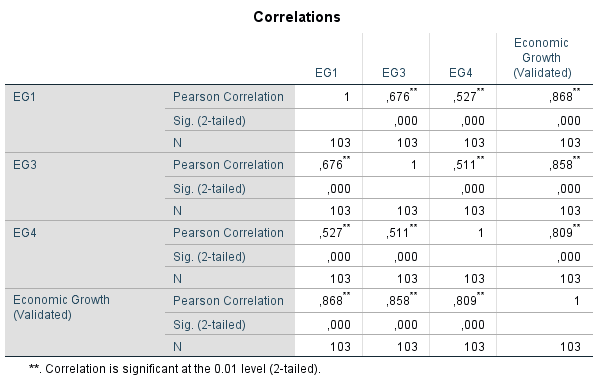
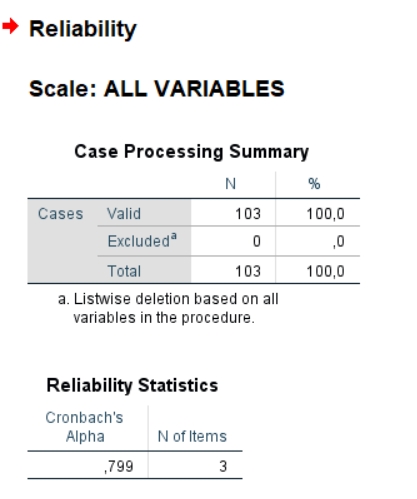
Regression Output
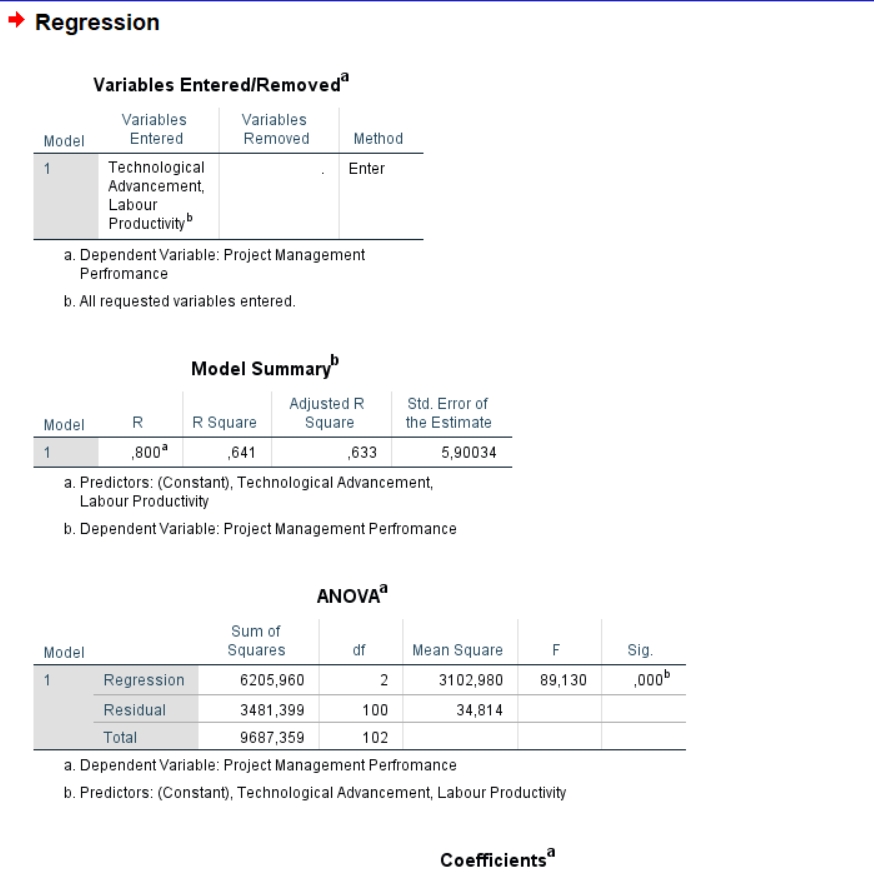
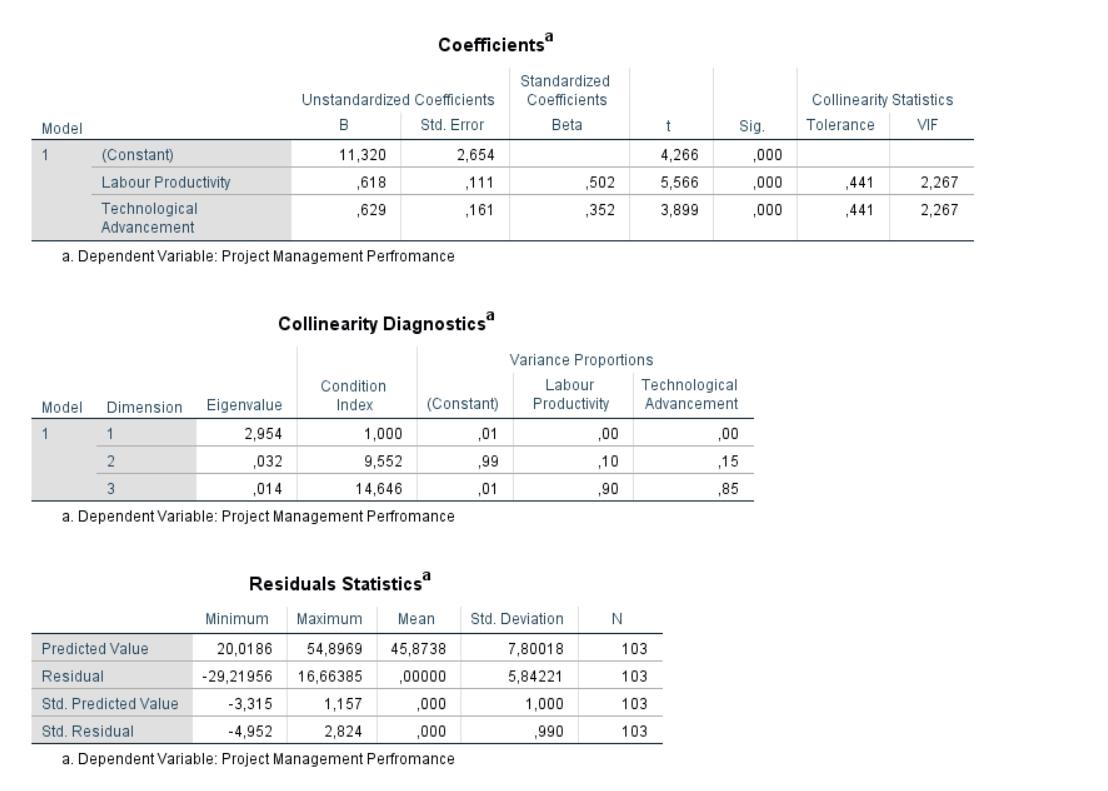
Single-Sample T-Test Output
